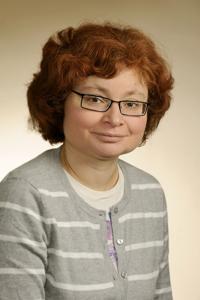
Emilia Galperin, PhD
About
Faculty Rank
- Associate Professor
Research
Research Focus
Our research program focuses on understanding the molecular mechanisms through which the fundamental MAPK1/2 pathway is regulated in space and in time.
To that end, we utilize comprehensive and interdisciplinary approaches that incorporate biochemistry, cell biology, state-of-the-art microscopy and vertebrate models. Our current focus is the scaffold protein Shoc2. We investigate how Shoc2 scaffold controls timing and cellular distribution of MAPK1/2 signaling and how Shoc2 itself is regulated by the ubiquitin machinery.
In our studies we integrate insights from basic research with the study of human cancers and congenital disorders. We believe that a better understanding of the molecular basis of malignant transformation will lead not only to further advances in biology but also novel and effective therapies.
Programs
Molecular and Cellular OncologyCollege & Department
Contact Information
741 S Limestone, BBSRB B169
Lexington, KY 40536
United States
Publications
- Shoc2-tranduced ERK1/2 motility signals - Novel insights from functional genomics.Jeoung M, Jang ER, Liu J, Wang C, Rouchka EC, Li X, Galperin E. Cell Signal. 2016 May;28(5):448-59. doi: 10.1016/j.cellsig.2016.02.005. Epub 2016 Feb 11.
- Spatial control of Shoc2-scaffold-mediated ERK1/2 signaling requires remodeling activity of the ATPase PSMC5.Jang ER, Jang H, Shi P, Popa G, Jeoung M, Galperin E. J Cell Sci. 2015 Dec 1;128(23):4428-41. doi: 10.1242/jcs.177543. Epub 2015 Oct 30.
- A Novel SHOC2 Variant in Rasopathy.Hannig V, Jeoung M, Jang ER, Phillips JA 3rd, Galperin E. Hum Mutat. 2014 Nov;35(11):1290-4. doi: 10.1002/humu.22634. Epub 2014 Sep 11.
- HUWE1 is a molecular link controlling RAF-1 activity supported by the Shoc2 scaffold.Jang ER, Shi P, Bryant J, Chen J, Dukhande V, Gentry MS, Jang H, Jeoung M, Galperin E. Mol Cell Biol. 2014 Oct 1;34(19):3579-93. doi: 10.1128/MCB.00811-14. Epub 2014 Jul 14.
- Three-chromophore FRET microscopy to analyze multiprotein interactions in living cells.Galperin E, Verkhusha VV, Sorkin A. Nat Methods. 2004 Dec;1(3):209-17. Epub 2004 Nov 18.
